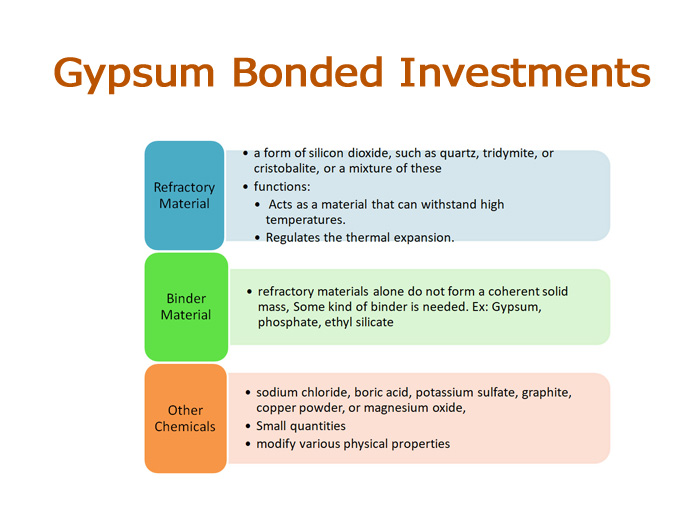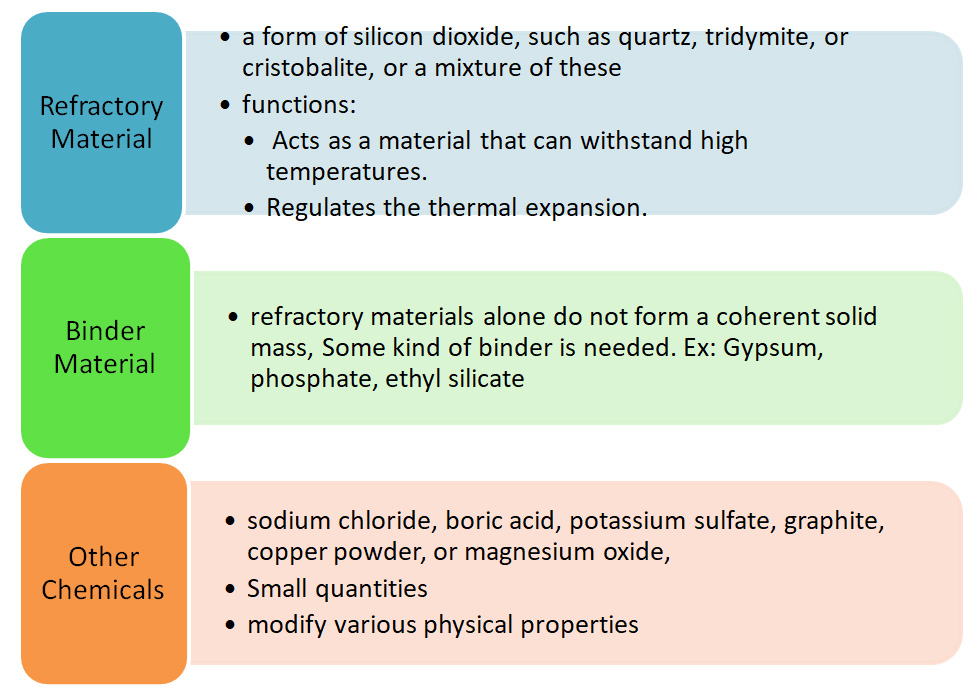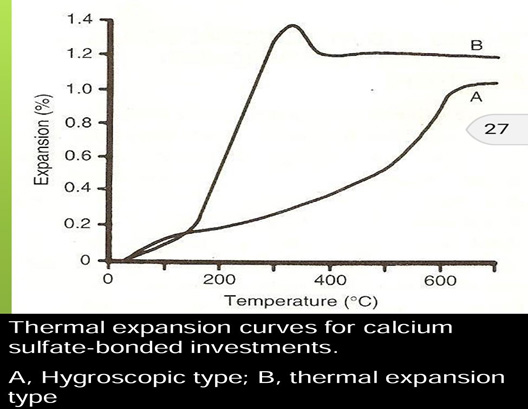- NEED HELP? CALL US NOW
- +919995411505
- [email protected]

A material which is suitable for forming a mould into which molten metal or alloy is cast
COMPONENTS OF INVESTMENT

PROPERTIES REQUIRED OF AN INVESTMENT
- Easily manipulated
- Sufficient strength at room temperature
- Stability at higher temperatures
- Sufficient expansion: compensate for shrinkage of the wax pattern and metal.
- Porosity: porous enough to permit the air or other gases in the mold cavity to escape.
- Smooth surface: Fine detail and margins on the casting.
- Ease of divestment
- Inexpensive
TYPES OF INVESTMENT
- Based on the nature of Binder
-
- Gypsum bonded investments
- Phosphate bonded investments
- Ethyl silica bonded investments
GYPSUM BONDED INVESTMENTS
ISO (1990) lists 3 types Gypsum Bonded of Investments:- Type I – for inlays and crowns utilizes thermal expansion of the mould.
- Type II – for inlays and crowns utilizes hygroscopic setting expansion.
- Type III – for gold partial denture utilizes thermal expansion.
COMPOSITION
1. Binder : 25% to 35% of α-calcium sulfate hemihydrate is used-To react with water and on hydration binds the silica together.
-To impart sufficient strength to the mould and
-To contribute to the mould expansion by its setting expansion.
-
- Casting gold-containing alloys with melting ranges below 1000 °C
- Material is heated at temperatures sufficiently high
– 200-400 °C: shrink considerably
– 400 °C - 700 °C : slight expansion takes place between
– Above : decomposition and the release of sulfur dioxide causing contamination of alloy
2. Refractory materials:65% to 75% quartz or cristobalite, or a blend of the two(form of silica)- It withstands high temperatures and
- Provides mould expansion by thermal expansion
-
- When heated allotropes of silica changes from α (low room temperature form) to β (high temperature form)
– Phase transformation is called an inversion.
– Causes linear expansion ,overall causing volume expansion
3. A reducing agent: such as powdered charcoal, reduces any oxide formed on the metal. If present should not be heated more than 650ºC4. Modifying chemicals: 2% to 3%: eg. boric acid or sodium chloride to shrinkage on heating.
PROPERTIES
SETTING TIME OF GYPSUM BONDED INVESTMENT
- ADA specification no.2 recommends minimum setting time of 5 mins. and a maximum of 25 minutes.
- The modern investments usually have a initial setting time between 9 to 18 minutes.

NORMAL SETTING EXPANSION
– silica particles probably interfere with the intermeshing and interlocking of the crystals
– thrust of the crystals is outward during growth,
– Soft wax and thin pattern may get distorted,
HYGROSCOPIC SETTING EXPANSION
- Expansion when contact with heated water.
- Greater in magnitude than normal setting expansion
- Type II investments : 1.2% - 2.2%
- Directly proportional
– Silica content of the investment
– Water mixed during setting reaction
- Indirectly proportional : size of silica particles
- Thermal expansion of silica must be increased to counterbalance the contraction of the gypsum
- Contraction of the gypsum is entirely balanced when the quartz content is increased to 75%
- Type I: 1% - 1.6%, Type II: - 0% and 0.6% at 500 °C
- It depends on
– Particle size of the quartz,
– Type of gypsum binder: α or β
– Resultant W/P ratio
– Allotropes of quartz : Cristobalite > quartz
THERMAL CONTRACTION– Inversion of the β form to its stable α form at room temperature.
– Contracts to less than its original dimension
EFFECT OF CHEMICAL MODIFIERS
– Increasing the silica content
– reduces the strength of investment
– Small amounts of sodium, potassium, lithium chlorides or boric acid
– eliminates the need for adding silica to cause expansion
STRENGTH
– Adequate to prevent cracking, bulk fracture, or chipping of the mold
– affected by the W/P ratio same way as gypsum.
– It decreases after heating to 700 0C – microcracks
FINENESS
– Fine silica results in a higher hygroscopic expansion
– Also it will give finer details accurately and minimal surface roughness.
MCQs
Gypsum in the investment acts as;A, Filler
B. Binder
C. Refractory
D. Reactor
Answer B



